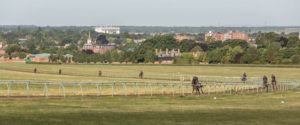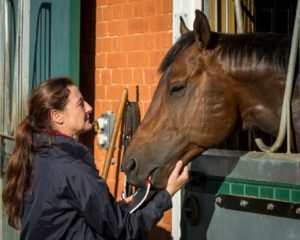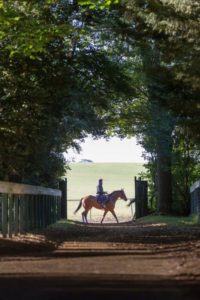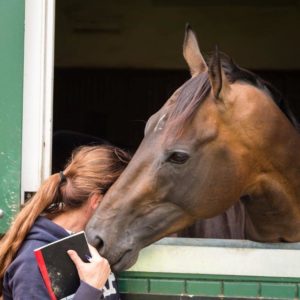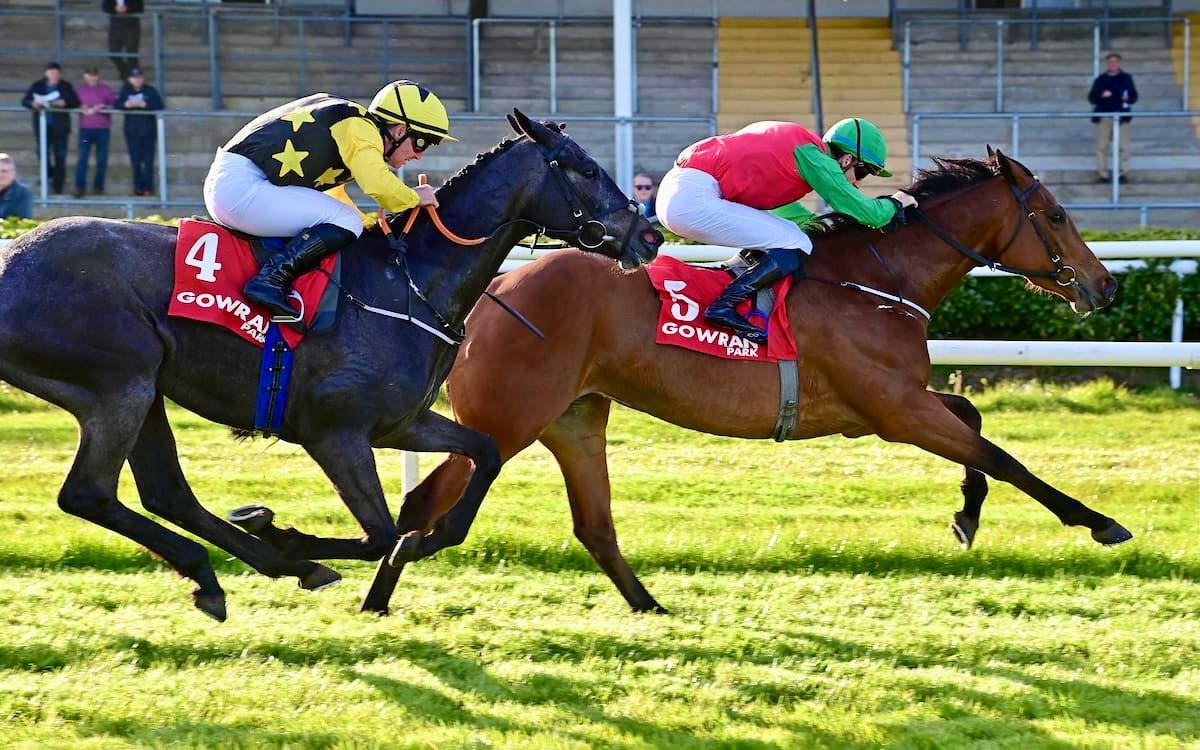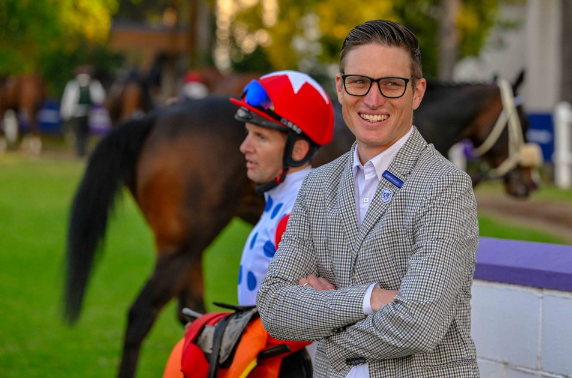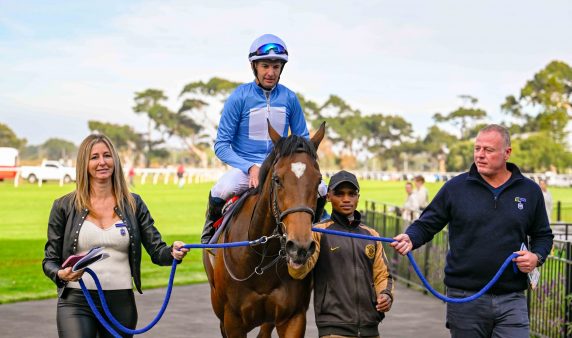This week’s column comes with grateful thanks to Mary Slack, the Mike de Kock team and Steven Jell and Declan Cronin in particular, who kindly opened the ornate wrought iron gates of Abington Place and allowed me to poke my nose and camera around their beautiful Newmarket facility.
I will remain forever indebted to Les Carlyon for his quote that what makes racing interesting is horses and people. At the risk of repeating myself, it is my distinct privilege that my column, battered bakkie and even more battered keyboard afford me a front row seat and occasionally the chance to shake hands or pat the necks of the best in the business.
A little history
Abington Place has exactly the right mix of elegance and provenance that makes England, and Newmarket in particular, such a singularly special place for racing fans. Situated on Newmarket’s picturesque Bury Road, the story of Abington Place begins right at those ornate gates. Flanked by Victorian red brick walls, the entrance is an imposing large stone archway with a set of magnificent wrought iron gates, the addition of a modern intercom system and electrical opening mechanism the only concession to progress. A keystone, set above the gate boasts the letters ‘MG’ for the original owner, Martin Gurry.
Before we go through, it’s worth retelling a little of Abington’s history. According to Newmarket’s National Horseracing Museum, Martin Gurry was born in modest circumstances in Nottingham and served his apprenticeship with William Oates in Middleham, C Winteringham and James Watson, before trying his hand on the flat. He worked as a head lad for Robert Peck, eventually progressing to becoming Peck’s private trainer at Park Lodge in Newmarket. At the end of the 1886 season, Gurry became the private trainer to the wealthy racehorse owner and breeder, George Alexander Baird, the most successful gentleman rider of his day, who raced under the name of Mr Abington. Baird was a controversial figure and his relationship with Gurry was tempestuous and short-lived. Gurry left his employ in 1888 and although he had to go all the way to court to obtain his severance pay, when he finally got them, Gurry used the proceeds to build his own stable yard, which he mischievously named ‘Abington Place’. The yard was designed by one John Flatman, the son of Elnathan ‘Nat’ Flatman, the first Champion Flat Racing Jockey of Great Britain, who won every English Classic except the Oaks during his career and held the championship for 13 consecutive years from 1840 and 1852. However, he is probably best remembered for besting The Flying Dutchman with Voltigeur in their famous Doncaster Cup duel.
The clock turret and foundation stone are dated 1889, but building work was not officially completed until 1895, when victory in the Oaks with La Sagesse provided Gurry with the means to finish construction. Gurry retired in 1917 to take up pig farming and Abington Place was sold to Alfred Sadler, on condition that Gurry could remain at Abington Place until he died. His wife is responsible for the beautiful garden. Sadler was briefly succeeded by Lord Beaverbrook, who in turn sold it to Harry Wragg in 1947. A former jockey, known as the ‘head waiter’ for his race riding patience, Wragg was one of the first trainers to campaign horses abroad. Harry handed the reins to his son Geoff in 1982 and in the early 2000’s, Mike de Kock rented a portion of yard for his Dubai raiding string. When Geoff retired, Mike’s patron Sheikh Mohammed bin Khalifa al Maktoum purchased the property in 2009 and more recently still, it changed ownership to Mary Slack.
Abington Place 2015
We crunched our way up the gravel driveway and found a leafy spot to park. We are greeted by an Australian Blue Heeler, hopefully proffering a deflated ball, followed shortly by his owner, Mike’s international assistant, Steven Jell.
The main yard is designed in a quadrangle, with rows of stables forming 3 sides of the square and the house and admin buildings the fourth. In the middle is an immaculate grass lawn with a magnificent bronze of a horse’s head set just above the water feature as a centre piece.
Of course it’s the flesh and blood inmates that we’re more interested in and it’s hard not to lose your breath, nevermind your composure being shown the likes of Mubtaahij, looking relaxed and peaceful after his US campaign, Red Ray who took a gastronomic interest in my notebook and Happy Valley, now 8 years old and completely white and looking an absolute picture. The main yard comprises 31 boxes and the inmates are a heady mix of some of the best racing blood on the planet. While I’m exclaiming about the incredible selection of breeding represented, Steven shrugs, “I know it sounds impressive, but that’s what it’s like over here. All the yards have horses like these – lots of them,” he says seriously.
Tremendous effort
One cannot admire how wonderful the horses look, without also marvelling at the tremendous obstacles they face simply to make it as far as the inside of those stables and then follows the inevitable discussion about African Horse Sickness and our export protocols. Steven talks us through some of the challenges the horses – and the people who travel with them – have to face on the journey, illustrating some of the finer points with photos from some of his many trips. And that’s merely the difficulties one encounters en route. Once you arrive at your destination, there’s a whole new set of logistical challenges to be faced, not least of which is setting up camp in the visitors barns of the world. However, with somewhere around 15 years’ experience under their belt, the De Kock team have got it down to a fine art and there are few quarantine centres, training barns or race tracks that they haven’t seen. Steven explains that this is one of the strategic reasons for being based at Abington Place. Although interested patrons are welcome to use Abington as a training facility to race in the UK, rather than being a ‘UK satellite’, it is intended as a base for any South Africans who want to try their hand – and their horses – at campaigning abroad and offering them the unparalleled infrastructure, expertise and support of the De Kock team. In an industry as competitive as ours, it is a heck of a gesture, but the intention is serious and it is very clear – to assist South Africa onto a firm footing on the world stage by all means possible.
Facilities
The second string heads out at six-thirty and we watch Mubtaahij and two companions warm up in the undercover ‘ride’, a large circular roofed structure where horses and riders can warm up out of reach of the worst of the elements. Mubtaahij is just coming into work after his holiday and still in light work, so he heads back to the stables while we follow his companions up the leafy pathway. Unlike a lot of Newmarket’s inmates who provide the wonderful tableau of horses hacking through town to reach the gallops, Abington Place residents have the great luxury of a short walk through the estate before exiting directly onto the gallops. We watch ‘our’ two horses work up the hill and then head back for a tour of the rest of the facilities.
In addition to the undercover ride, there are 3 horse walkers with specialist surfaces, a treadmill situated in one of the outer covered barns as well as several turnout options, again with a variety of surfaces to help rehab horses’ feet. Quizzed on more detail, Steven says to ask Declan (Cronin), farrier extraordinaire and an integral part of the Mike de Kock team, but warns that the answer might be a long one. On our way back to the main yard, we take a peek into the feed and tack rooms. The feed room is the engine room of any yard and the Abington Place one is perhaps my favourite by far. Like military flags adorning medieval dining halls, the walls are decorated with the saddle cloths worn by some of their most famous horses in some of their most famous exploits on some of the biggest race courses of the world. It is a shrine to all the greats that have gone before and is both a testament to how far South Africans have come on the world stage as well as serving as inspiration for those who are yet to come. Heady company indeed.
Mubtaahij
I can’t leave without going to chat to Mubtaahij in his box and Steven kindly lets us give their star inmate a pet and some fuss. He is taller than he looked on the TV coverage of his US trip, but for all that, is not a particularly masculine or physically imposing specimen. What is striking though, is his temperament. It was commented on frequently by the foreign press during his US campaign and it is all cross-my-heart true. He has that quiet confidence about him peculiar to really good horses and it is an experience just to stand in the box next to him. He is gentle as a lamb and calmly accepts our intrusion without so much as needing a halter, sticking his head out over the door for more attention when we leave.
I start remarking on how kind he is and then realise that despite the majority of the horses being entires, they have all been remarkably good natured. “Happy horses generally have good temperaments,” says Steven. “All our horses get treated well and get attention every day.” The horses certainly bear this out.
To borrow another phrase from Mr Carlyon, “When horses, or those who ride or train them, do rare things, they make the people who were present that day feel good.” Thank you to Mary, the Mike de Kock team and everyone at Abington Place for a magical visit – we left feeling very good indeed.



